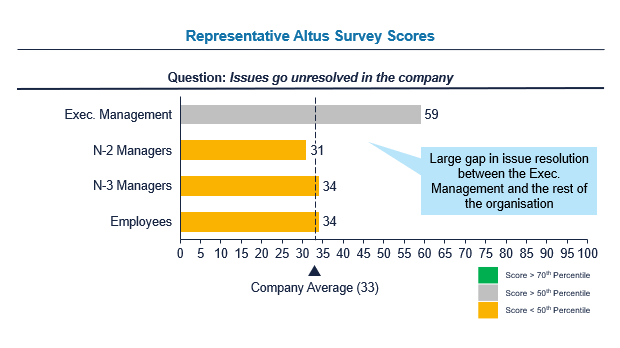
Humatica has pioneered analytical tools and methods to open the black box around middle management readiness and ensure smooth implementation of the value creation plan.
In particular, two key methods shed a hard-facts light on Middle Management’s readiness for the next step in the value growth journey:
Utilizing a management process Maturity Model to conduct structured interviews on critical management processes for executing the value creation plan is a pragmatic and efficient way to assess middle management readiness. Maturity models come from the IT-world where they are used to classify the level of competence of programmers. They codify what good looks like at different levels of maturity.
The approach can be applied to management processes, which are otherwise not codified and left up to each manager to define as they see fit: A small independent shop likely manages field sales differently from a highly structured large corporate. A documented maturity model for management processes enables a pragmatic evaluation of the maturity level and readiness of middle managers in key functions.
To objectively assess management process maturity, it’s instructive to ask simple questions about how middle managers lead their teams. How often do they meet? What do they discuss? Meeting agendas? KPIs? Do they note action items and follow-up? Are management processes being followed consistently across the organisation and best practice management behaviours shared?
There is not one right management process. However, the approach quickly identifies management processes that are clearly not mature enough to execute the value creation plan. This is where middle managers may simply not know what good looks like – a actionable reflection of their readiness level.
Humatica’s Altus behavioural benchmarking tool and database can be used to measure the quality of behaviours and collaboration in each manager’s area and between levels. In particular, the behaviours which drive the collective ability of a team to make good decisions and implement are critical for implementation of the value creation plan, and are driven primarily by the direct manager’s leadership.
Benchmarking specific basic good governance behaviours like whether action-items are documented or followed-up on in a team is therefore revealing about the quality of mid-level leadership. And, by measuring specific team behaviors, identified outliers are translated into directly relevant improvement tips back to the team’s manager. Altus is thereby an essential tool to identify bottlenecks in middle management and accelerate leadership development where the rubber hits the road.
The approach is also used to identify dysfunctional gaps between management hierarchical levels that hinder the effective flow of information and implementation, so that these can be addressed. (see Figure 1).

This article is part of our series on Organizational Excellence.
Other articles in the series:
Please subscribe below for future insights.

Resilience isn’t a buzzword anymore—it’s the make-or-break factor for portfolio companies navigating today’s volatility. That was the takeaway from the standout panel at the PE…
Read more
Rightsizing an organization is never easy. But, it is a normal process as firms adapt to changing market requirements. More recently, higher interest rates, AI…
Read more
The promise of AI and turbulence introduced by the Trump tariffs have renewed focus on rightsizing and efficiency improvement as levers for value creation and…
Read moreReceive our news and valuable perspectives on organizational effectiveness each month.